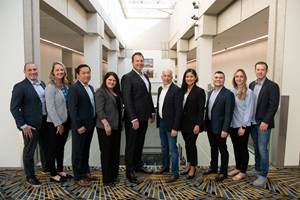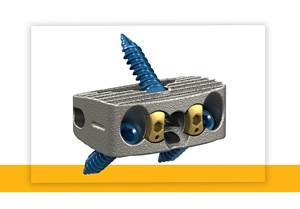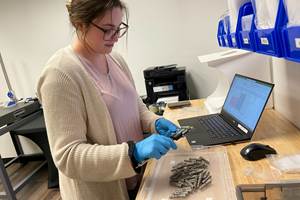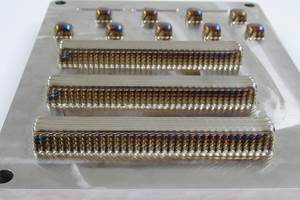Metal 3D-Printed Implants Are Helping Injured Racehorses
A successful collaboration between Clinique de Grosbois and French service bureau 3D Medical is driving positive outcomes in equine medicine with the development of a new type of prosthesis that improves healing.

Metal 3D printing has enabled the development of a new type of prosthesis that improves healing and will hopefully positively improve the outcome for injured racehorses. Photo Credit: 3D Medical
A collaboration between Clinique de Grosbois and French service bureau 3D Medical is driving positive outcomes in equine medicine with their neck generation innovation involving metal 3D-printed implants to help injured racehorses.
Neck and vertebral fractures caused by falls at high speed are some of the most common causes of injury in racehorses. Equine veterinary surgeon Dr. Fabrice Rossignol and his team at the Clinique de Grosbois, located southeast of Paris, France, have been exploring the potential of metal 3D printing implants for treating neck fracture cases.
In the past, it was not uncommon for horses with neck fractures to be euthanized, sometimes within hours. It is difficult, especially with open fractures, to rehabilitate the animal because racehorses are not animals that can lie down for months, and immobilizing them is almost impossible. Additionally, the cost of an operation and subsequent convalescence is often very high, which unfortunately affects the decision of some owners.
Given some of the technical restrictions of using conventionally manufactured implants, Dr. Rossignol and his colleagues began exploring the potential of using metal 3D printing within equine medicine for neck fracture cases. “We’ve ended up with a new type of prosthesis that improves healing and hopefully will positively improve the outcome for as many animals as possible,” says Vincent Nuttens, 3D Medical CEO.
During surgery, the injured horse is anesthetized and placed in a surgical hammock to immobilize it. The fracture is stabilized with a 3D-printed plate and 3D-printed cancellous screws bridging the vertebrae (depending on the case and the vertebrae affected) with a small 3D-printed titanium cage applied in the ventral disc space. Cancellous or cortical screws may sometimes be associated with the locked screws to enable compression of the fractured fragment.
The company says the benefit of this assembly lies in that the 3D-printed titanium intervertebral spacer used during surgery makes use of compression forces to preserve the spacing between the vertebrae. The shape of the plate enables the placement of three screws in each vertebra. In addition, the company says implants manufactured using titanium alloys have shown better osseointegration than steel implants. And, unlike conventional machining, metal 3D printing enables the creation of porous patterns that facilitate the growth of bone through the cage and the fixation of the bone onto the cage.
Finally, the screws used are self-tapping and partially self-drilling, which enables maximum anchorage , while reducing the risk of perforation during drilling or tapping. “The three major features and benefits of the metal 3D implant are its precision of custom printing and its resistance to a force and weight (a horse’s weight is significantly greater than a human’s), as well as the postoperative mobility of the animal,” Rossignol says.
The procedure is performed under radiographic or fluoroscopic control and, so far, few complications have been noted, the company says.
In the postoperative period, the horses are left free in the stall for one month. Then, they are gradually rehabilitated by hand walking, with a walker and in the paddock, until they are gradually returned to activity (between the fifth and eighth month) after a clinical and radiographic test.
“Metal 3D printing allows us to be inventive, which gives us very encouraging long-term (care) of our four-legged companions,” Nuttens adds.
Related Content
GE Additive, Orchid Collaborate on 3D Printing Orthopedic Joint Implants
The agreement bolsters the use of additive manufacturing in the medical implants sector with the development of electron beam melting solutions.
Read MoreStryker Using Additive for Implants
Using its “AMagine” process, Stryker creates components with a titanium alloy that mimics bone.
Read MoreProduction AM Demands Process and Procedures — More Machines Will Come Later
Arch Additive has transitioned to full production of implants made through electron beam melting. The transition has involved practices and personnel, not equipment. As customer products win approval and go to market, here are 5 operational moves the AM implant manufacturer has made.
Read MoreMSU, AddiTec Collaborate to Develop Biocompatible Bone Implants
The collaboration focuses on enhancing Ti-6Al-4V implant properties by incorporating alloying elements such as Tricalcium phosphate to the Ti-6Al-4V melt pool matrix — which cannot be done conventionally.
Read MoreRead Next
4 Ways the Education and Training Challenge Is Different for Additive Manufacturing
The advance of additive manufacturing means we need more professionals educated in AM technology.
Read More3D Printing Brings Sustainability, Accessibility to Glass Manufacturing
Australian startup Maple Glass Printing has developed a process for extruding glass into artwork, lab implements and architectural elements. Along the way, the company has also found more efficient ways of recycling this material.
Read MoreHybrid Additive Manufacturing Machine Tools Continue to Make Gains (Includes Video)
The hybrid machine tool is an idea that continues to advance. Two important developments of recent years expand the possibilities for this platform.
Read More










.png;maxWidth=300;quality=90)











